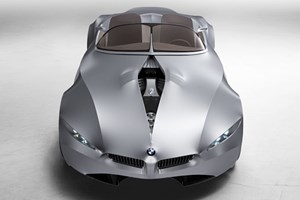By Nargess Shahmanesh-Banks
First official pictures
10 June 2008 00:00
Who’d have guessed that BMW’s latest concept car would be made of cloth? The GINA Light Visionary Model – unveiled today – is a far-flung research concept from Munich that has shaped the latest generation of BMWs. This car can change shape and surface at the flick of a switch, and the 'GINA' principles it espouses have been used to craft today's BMW design language.
Fancy flame surfacing today? No worries – tap a switch and your bodywork goes all taut-edged and angry. Prefer to go more classical and clean-edged? Not a problem. GINA does it all.
BMW GINA: what it all means
BMW design has been known to ruffle a few conservative feathers in the past, and today's disclosure of its GINA process is bound to raise eyebrows. Standing on its 20-inch alloys, the Light Vision Model concept looks like a modern-day BMW sports car, displaying taut sculpted muscles and the brand’s unmistakable signature form language of flame surfacing.
Yet the Light Visionary Model is not made of metal but of cloth. The virtually seamless stretch fabric is secured on a meshwork of metal wires that shields the movable substructure beneath.
Made of cloth?! Has Chris Bangle finally lost the plot?
Bear with us here. The BMW group design director explained at length to CAR the method in his madness at a private viewing ahead of the official media launch in the newly renovated BMW museum in Munich.
The Light Vision Model is part of a project that has shaped BMW design for a decade and led to ground-breaking developments such as iDrive and flame surfacing. It's the ultimate expression of the company's GINA design mantra. ‘The cloth can change your mind about what a car can be,’ he says mysteriously.
So how much can the BMW Light Vision Model change shape? Are we talking Transformers here?
There’s more to GINA than its fabric skin – this car allows for extreme degrees of personalisation, as individual elements of the substructure are movable too. Electro-hydraulically controlled, they change their position to help the flexible fabric skin move to take on entirely new shapes.
For instance, as soon as the driver flicks on the lights, the closed fabric covering over the Light Vision Model's headlights gradually unpeels, making the car seem almost alive.
Another sensor slowly opens the door, triggering shark-like creases across the profile. Another lifts the beltline slightly, forming a more aggressive stance.
And inside BMW's GINA concept?
Prepare to step into the concept's stark cloth cabin, and the car awakens; the centre console and instrument panel swivel to almost cocoon the driver and previously invisible headrests delicately rise from the minimalist seats.
It’s an eerily weird experience – this car lays bare the thinking that has been shaping future BMWs for the most part of this decade. Only now that Bangle's revolution is over have the top brass in Munich allowed this internal concept car to be revealed.
‘We are going to have to find new ways to adapt to how the world sees cars, what they want from them and over what lifespan,’ explains Bangle. ‘In this context, we have to offer a product that is more about lifestyle and personalisation statements.’
BMW Light Vision Model: based on a Z8
The two-seater roadster you see here is based on a Z8 chassis, as BMW’s Californian think-tank Designworks was working on the spaceframe car around the same time it started the GINA project. The concept was then shipped over to Munich where head of exterior design, Anders Warming, evolved it into a full-life sculpture.
So just how much should we read into this latest, old-but-new and very definitely zany BMW concept car? The Munich company – like others – is always probing future techs and sometimes works at a very advanced level of crystal-ball gazing.
BMW’s designers argue that it’s only through such experimentation that we’ve ended up with today’s iDrive multi-controller (although some would debate whether that’s a good thing…).
For all its sins, iDrive is one example of personalisation – by giving customers the choice of which functions to display on the menu screen.
Enough claptrap! Will BMW ever build cloth cars?
Get real. Of course BMW is not seriously planning to build cars made from cotton or nylon. The GINA programme is all about ideas – this is a concept car in the classic, exploratory sense of the phrase.
‘It was like a lightning rod triggering discussions on where this could lead in terms of production and manufacturing,’ Bangle claims. BMW regularly challenges current manufacturing methods and is working on rapid systems that allow a way of digitally creating car parts for a fraction of the cost; this was actually used to craft the Z4 M’s bonnet, apparently.
BMW's GINA thinking: a long-range forecast
‘It would be wrong to say BMW’s future is cloth cars,’ says Bangle. ‘But it does make you think about cars differently – that’s the whole idea behind it.’
So Gina is a future vision of the automobile, and an object of research.
‘The M1 Hommage and CS concepts are where we are at aesthetically,’ says Bangle. ‘This car is about far in the future.’




















